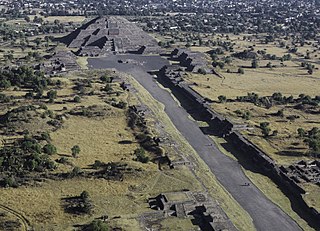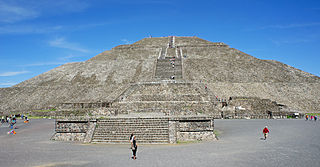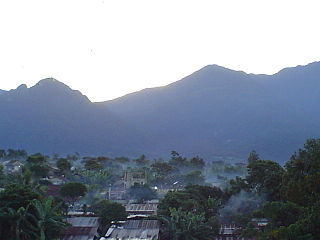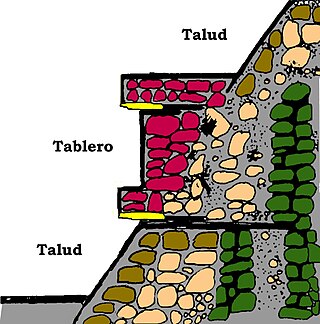This is a list of Mesoamerican pyramids or ceremonial structures. In most cases they are not true pyramids. There are hundreds of these done in many different styles throughout Mexico and Central America. These were made by several pre-Columbian cultures including the Olmecs, Maya, Toltecs, and Aztecs. In most cases they were made by city states that created many structures in the same style. The style for each city state is usually different. These are usually made out of stone and mortar but some of the earliest may have been made out of clay.
| Site | Name of Pyramid | Culture | Base length (m) | Height (m) | Incli- nation | Approximate Time of Construction | Function | Notes | Image |
|---|---|---|---|---|---|---|---|---|---|
| Altun Ha Belize | Maya | 16 | 200 to 900 CE |  | |||||
| Cañada de la Virgen Mexico | Otomi | 15+ | 540 to 1040 CE | The Pyramids and surrounding complex were built to house priests, along with serving as a burial ground. | These are the only Otomi pyramids we currently know of. |  | |||
| Caracol Belize | Caana | Maya | 43 | A triadic pyramid, Caana is the highest man-made structure in Belize |  | ||||
| Caracol Belize | Temple of the Wooden Lintel | Maya | |||||||
| Lamanai Belize | High Temple | Maya | 33 | Pre-Classic Period |  | ||||
| Lamanai Belize | Jaguar Temple | Maya | 20 | Pre-Classic Period |  | ||||
| Lamanai Belize | Mask Temple | Maya | 17 | Early Classic Period | 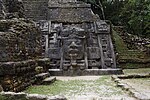 | ||||
| Lubaantun Belize | Maya | 730 to 890 CE | Lubaantun's structures are mostly built of large stone blocks with no mortar, using primarily black slate rather than limestone. | 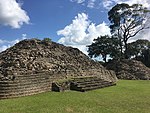 | |||||
| Tula Mexico | Piramid B | Toltec | The pyramid is dedicated to Quetzalcoatl, and topped with Atlantean columns, carved like warriors. | ||||||
| Lubaantun Belize | Maya | 730 to 890 CE | Lubaantun includes many small step pyramids in addition to its far larger one. | 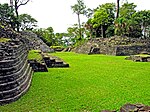 | |||||
| Nim Li Punit Belize | Maya | Tallest 12 | 400 to 800 CE | Nim Li Punit has several small-step pyramids, but none that possessed the sheer mass of other examples. |  | ||||
| Xunantunich Belize | El Castillo | Maya | 40 | 600 to 900 CE | 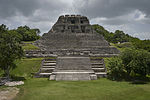 | ||||
| San Andrés El Salvador | the Bell of San Andrés | Maya | 600 to 900 CE | This is a scale model of structure 5. There are several other smaller structures that may be similar to pyramids on the site. |  | ||||
| Tazumal El Salvador | Maya | 250 to 900 CE |  | ||||||
| Aguateca Guatemala | Maya | 6 | 760 to 830 CE | This temple pyramid was left unfinished when the city was abandoned. Its purpose is still unknown. |  | ||||
| Dos Pilas Guatemala | LD-49 | Maya | 20 | after 629 CE | This pyramid's main stairway (known as Hieroglyphic Stairway 2) contains at least eighteen hieroglyphic steps. However, some glyphs are undecipherable due to age. | ||||
| Dos Pilas Guatemala | Maya | after 629 CE | This temple pyramid was built by enlarging and terracing a natural hill some way from the site core, giving the impression of a single massive structure. | ||||||
| Kaminaljuyu Guatemala | Maya | 250 CE | Kaminaljuyu contains some 200 platforms and pyramidal mounds, at least half of which were made before 250 CE. Some were used to hold temples. |  | |||||
| El Mirador Guatemala | La Danta | Maya | 72 | 300 BCE to 100 CE | La Danta pyramid temple has an estimated volume of 2,800,000 cubic meters, making it one of the largest pyramids in the world. | ||||
| El Mirador Guatemala | El Tigre | Maya | 55 | 300 BCE to 100 CE |  | ||||
| El Puente Honduras | Structure 1 | Maya | 12 | 600 BCE- 900 CE | Religious temple | ||||
| Mixco Viejo Guatemala | Maya | 1100 to 1500 CE |  | ||||||
| Tikal Guatemala | Maya | 47 |  | ||||||
| Copán Honduras | Maya | Copán has several overlapping step-pyramids. |  | ||||||
| Bonampak Mexico | The Temple of the Murals | Maya | 580 to 800 CE |  | |||||
| Calakmul Mexico | The Great Pyramid | Maya | 55 | 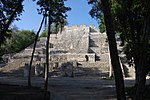 | |||||
| Chichen Itza Mexico | El Castillo | Maya | 55.3 | 30 |  | ||||
| Cholula Mexico | The Great Pyramid of Cholula | Aztec | 450 sq. | 66 | 300 BCE - 800 CE | The largest pyramid and the largest manmade monument anywhere in the Americas. |  | ||
| Coba Mexico | The Nohoch Mul pyramid | Maya | 42 | 500 to 900 CE |  | ||||
| Coba Mexico | La Iglesia | Maya | 20 | 500 to 900 CE |  | ||||
| Coba Mexico | Crossroads Temple | Maya | 500 to 900 CE | 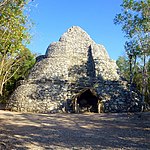 | |||||
| Comalcalco Mexico | Temple 1 | Maya | 20 | 600 CE to 900 CE | The city's buildings were made from fired-clay bricks with mortar made from oyster shells, unique among Maya sites. Many are decorated with iconography and/or hieroglyphs. |  | |||
| El Tajín Mexico | Pyramid of the Niches | Classic Veracruz | 18 | 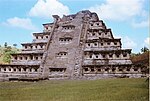 | |||||
| La Venta Mexico | The Great Pyramid | Olmec | 33 | 394 ± 30 BCE | This is one of the earliest pyramids known in Mesoamerica. It was made out of an estimated 100,000 cubic meters of earth fill. | 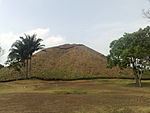 | |||
| Mayapan Mexico | Maya | 15 |  | ||||||
| Moral-Reforma Mexico | Conjunto 14 | Maya | 37 |  | |||||
| Palenque Mexico | Temple of the Cross | Maya | 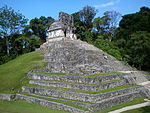 | ||||||
| Palenque Mexico | Temple of the Inscriptions | Maya | >675 | Bore the Classic Maya name B'olon Yej Te' Naah "House of the Nine Sharpened Spears". | 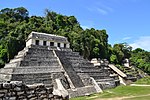 | ||||
| Santa Cecilia Acatitlan Mexico | Aztec | In 1962, the architect and archaeologist Eduardo Pareyon Moreno reconstructed the pyramid's basement and the temple that crowns it. |  | ||||||
| Tenayuca Mexico | Aztec | 62 by 50 | This is the earliest example yet found of the typical Aztec double pyramid, which consists of joined pyramidal bases supporting two temples. |  | |||||
| Tenochtitlan Mexico | Templo Mayor | Aztec | 100 by 80 | 1390 to 1500 CE | Tenochtitlan was destroyed by the Spanish. Recreations of this and other pyramids are based on historical text and archaeological ruins. |  | |||
| Tenochtitlan Mexico | Aztec | 1325 to 1521 CE | Tenochtitlan, the Aztec capital city, was completely razed by the Spanish conquistadors led by Hernán Cortés. Recreations the city are based on historical text and archaeological ruins. This site once included at least half a dozen pyramids. | 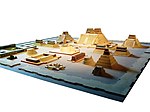 | |||||
| Teotihuacan Mexico | Pyramid of the Sun | Teotihuacano | 223.5 | 71.2 | 32.5 | 100 BCE | There are also dozens of platforms 4 stories high lining the Avenue of the Dead at Teotihuacan. Each step in each story creates a stairway to the top in front of the platforms. |  | |
| Teotihuacan Mexico | Pyramid of the Moon | Teotihuacano | 43 | 100 BCE | 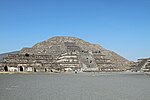 | ||||
| El Tepozteco Mexico | Aztec | 1502 CE |  | ||||||
| Tula, Hidalgo Mexico | Toltec |  | |||||||
| Uxmal Mexico | Pyramid of the Magician | Maya | 40 |  | |||||
| Uxmal Mexico | La Gran Piramide | Maya | 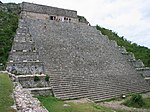 | ||||||
| Xochicalco Mexico | Temple of the Feather Serpent | 200 BCE to 900 CE | 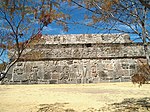 | ||||||
| Xochicalco Mexico | 200 BCE to 900 CE | This is one of several other step-pyramid temples in addition to the Temple of the Feather Serpent | 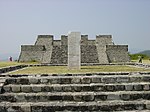 | ||||||
| Xochitecatl Mexico | The Pyramid of Flowers | 100 by 140 | the Preclassic Period |  | |||||
| Xochitecatl Mexico | The Spiral Building | 700 BCE | This is a circular stepped pyramid. The interior consists of volcanic ash. The building has no stairway to the top, it was climbed by following the spiral form of the building itself. | ||||||
| Yaxchilan Mexico | Maya | 600 to 900 CE | This is one of the pyramids on the upper terrace of Yaxchilan |  | |||||
| Yarumela Honduras | Estructure 101 | Lenca | 20 | 1000 BCE to 250 CE | Religious temple used for different ceremonies |  | |||
| Tikal Guatemala | Tikal Temple IV | Maya | 88 by 65 | 70 | 741 AD | The pyramid was built to mark the reign of the 27th king of the Tikal dynasty | Temple IV at the Classic Period Maya ruins of Tikal, 8th century AD, Peten Department, Guatemala. | 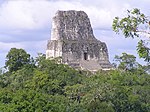 | |
| Tzintzuntzan Mexico | 5 yácata pyramids | Purépecha | Late post-classic period | The pyramids are rounded and have a distinguishable T-like shape. |  |





